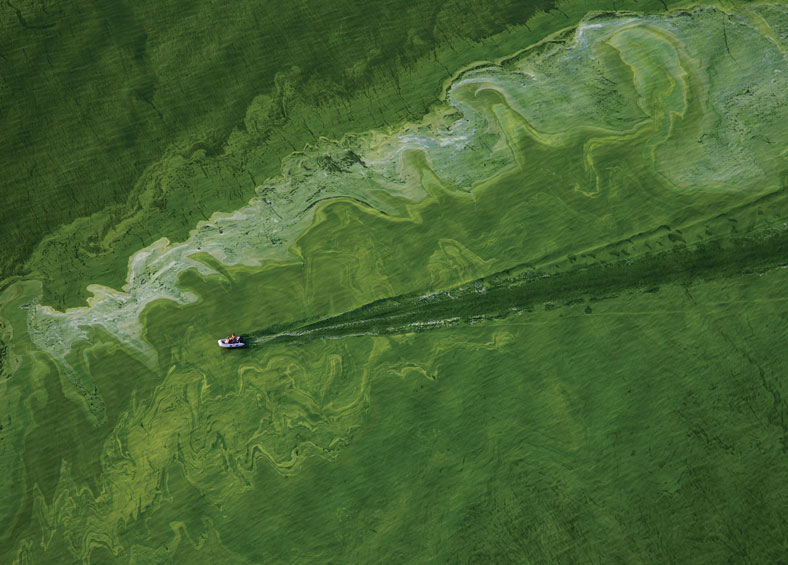
In the late ’90s, something eerie began to appear in the second smallest of the Great Lakes: toxic algal blooms that turned the waters of Lake Erie into a dangerous blue-green soup every July until October.
Comprised of cyanobacteria, the slick algae, which spans up to 600 square miles, feeds off the nitrogen in agricultural runoff from farms in places like Toledo, Ohio. It’s there, along the banks of the western tip of the lake, that The Erie Situation—the first full-length documentary from environmental filmmaker David Ruck, SOC/MFA ’13, is set.
Coproduced by Plastic Oceans International, a nonprofit committed to ridding the planet of plastic pollution, The Erie Situation premiered in March at the Cleveland International Film Festival, taking home the top award in the global health competition.
The idea for a documentary about a Great Lake gone bad came after Ruck, president of Great Lakes Outreach Media, partnered with the Ocean Conservancy to chronicle NOAA’s use of buoys to monitor conditions on the eastern end of the lake, where the blooms migrate after they die, compromising the drinking water in places like Cleveland. One of the engineers who oversees the network of buoys encouraged Ruck to head to Toledo to learn what was causing the yellow tap water in Forest City.
“For these communities that are right on the lake, if the winds are right, they are inundated with these toxic algal blooms. It has a meaningful impact on both the health of the folks living there as well as the industries in which they make a living,” says Ruck, whose tale of troubled waters includes protagonists like Ken Sabin, a boat builder who suspects the lake is to blame for his respiratory issues, and Joe Hammon, a certified organic farmer struggling to convince others to adopt sustainable practices.
“It was sort of like peeling away the layers of an onion. I started with one question and it snowballed from there,” Ruck continues. “I just kept shooting—on farm fields and research labs, from airplanes and boats—until I knew in my heart that I had a grasp of the story.”
Eight months and 110 hours of footage later, Ruck needed an editor. Maggie Burnette Stogner, executive director of SOC’s Center for Environmental Filmmaking, connected him with Grace Eggleston, SOC/MA ’21, who was looking for a thesis project after COVID yelled “cut” on her film about the threats posed to the Great Lakes by Asian carp.
“This was a huge project to drop in anyone’s lap, let alone someone who was still in school. I was waiting for Grace to be overwhelmed, but she was cool, calm, and steady the whole way through,” says Ruck, whose own AU thesis project, I Want to Be an Astronaut, premiered 285 miles above Earth, where it was screened aboard the International Space Station in 2014. “I’m proud to have worked with another Eagle to get this made.”
The native Michigander is also proud to have told a story so near to his roots and dear to his heart.
“The Great Lakes have always been special to me. Growing up on Lake Michigan, we haven’t really dealt with harmful algal blooms,” Ruck says. “But after being embedded with the best scientific minds in the Great Lakes community, I can now have a conversation with anyone, anywhere, about what these things are and why they are a serious and direct threat to water supplies throughout the country and around the world.
“This may be a regional story, but the problem isn’t unique to Lake Erie. Wherever there’s concentrated agriculture in proximity to vulnerable bodies of water, there’s the potential for harmful outcomes, and we’re seeing toxic algal blooms in lakes, rivers, and streams that never used to have them,” Ruck continues. “If we continue misusing the land, at some point it’s going to be in your community.”